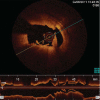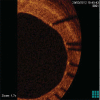Research and clinical applications of optical coherence tomography in invasive cardiology: a review
- PMID: 24893934
- PMCID: PMC4101202
- DOI: 10.2174/1573403x10666140604120753
Research and clinical applications of optical coherence tomography in invasive cardiology: a review
Abstract
In cardiology, optical coherence tomography (OCT) is an invasive imaging technique based on the principle of light coherence. This system was developed to obtain three-dimensional high resolution images to examine coronary artery normal and/or pathological structure. This technique replaces the ultrasound used by its main alternative procedure, intravascular ultrasound, by a near-infrared light source. Acute coronary syndromes due to atherosclerotic vascular disease are the leading cause of mortality in developed and developing countries. As a consequence, intravascular imaging systems became an important area of research and 1991 marks the first use of OCT in coronary artery observations. Since its first appearance in invasive cardiology, OCT maintains a strong presence in the research environments for the identification of vulnerable plaques, as it is able to overcome difficulties presented by other techniques such as virtual intravascular ultrasound, near-infrared spectroscopy, and histology. Moreover, OCT is increasingly being used in the clinical practice as a guide during coronary interventions and in the assessment of vascular response after coronary stent implantation. This review focuses on the relevance of OCT in research and clinical applications in the field of invasive cardiology and discusses the future directions of the field.
Figures




Similar articles
-
The diagnostic value of intracoronary optical coherence tomography.Herz. 2011 Aug;36(5):417-29. doi: 10.1007/s00059-011-3487-7. Herz. 2011. PMID: 21744151 Review.
-
Current applications of optical coherence tomography for coronary intervention.Int J Cardiol. 2013 Apr 30;165(1):7-16. doi: 10.1016/j.ijcard.2012.02.013. Epub 2012 Mar 8. Int J Cardiol. 2013. PMID: 22405134 Review.
-
Clinical use of intracoronary imaging. Part 2: acute coronary syndromes, ambiguous coronary angiography findings, and guiding interventional decision-making: an expert consensus document of the European Association of Percutaneous Cardiovascular Interventions.Eur Heart J. 2019 Aug 14;40(31):2566-2584. doi: 10.1093/eurheartj/ehz332. Eur Heart J. 2019. PMID: 31112213
-
Optical coherence tomography: from research to practice.Eur Heart J Cardiovasc Imaging. 2012 May;13(5):370-84. doi: 10.1093/ehjci/jes025. Epub 2012 Feb 13. Eur Heart J Cardiovasc Imaging. 2012. PMID: 22330231 Free PMC article. Review.
-
Stent evaluation with optical coherence tomography.Yonsei Med J. 2013 Sep;54(5):1075-83. doi: 10.3349/ymj.2013.54.5.1075. Yonsei Med J. 2013. PMID: 23918554 Free PMC article. Review.
Cited by
-
Optical Methods for Brain Tumor Detection: A Systematic Review.J Clin Med. 2024 May 2;13(9):2676. doi: 10.3390/jcm13092676. J Clin Med. 2024. PMID: 38731204 Free PMC article. Review.
-
Clinical translation of handheld optical coherence tomography: practical considerations and recent advancements.J Biomed Opt. 2017 Dec;22(12):1-30. doi: 10.1117/1.JBO.22.12.121715. J Biomed Opt. 2017. PMID: 29260539 Free PMC article.
-
Experimental and numerical investigation of wavelength and resolution dependency of dynamic optical coherence tomography signals.Biomed Opt Express. 2025 Jul 7;16(8):3084-3104. doi: 10.1364/BOE.564030. eCollection 2025 Aug 1. Biomed Opt Express. 2025. PMID: 40809984 Free PMC article.
-
An Intraoral OCT Probe to Enhanced Detection of Approximal Carious Lesions and Assessment of Restorations.J Clin Med. 2020 Oct 12;9(10):3257. doi: 10.3390/jcm9103257. J Clin Med. 2020. PMID: 33053724 Free PMC article.
-
Robust three-dimensional registration on optical coherence tomography angiography for speckle reduction and visualization.Quant Imaging Med Surg. 2021 Mar;11(3):879-894. doi: 10.21037/qims-20-751. Quant Imaging Med Surg. 2021. PMID: 33654662 Free PMC article.
References
-
- Prati F, Regar E, Mintz GS , et al. Expert review on methodology. terminoogy.and clinical applications of optical coherence tomography physical principles., methodology of immune acquisition., and clinical application for assessment of coronary arteries and atherosclerosis. Eur Heart J. 2010;31: 401–15. - PubMed
-
- Barlis P, Schmitt JM. Current and future developments in intracoronary optical coherence tomography imaging. EuroIntervention. 2009;4:529–34. - PubMed
-
- Tearney GJ, Regar E, Akasaka T , et al. International Working Group for Intravascular Optical Coherence Tomography (IWG-IVOCT).Consensus standards for acquisiion.measurement., and reporting of intravascular optical coherence tomography studies a report from the International Working Group for Intravascular Optical Co herence Tomography Standardization and Validation. J Am Coll Cardiol. 2012;59:1058–72. - PubMed
-
- Ozaki Y, Kitabata H, Tsujioka H , et al. Comparison of contrast media and low-molecular-weight dextran for frequency-domain optical coherence tomography. Circ J. 2012;76:922–7. - PubMed
-
- Takarada S, Imanishi T, Liu Y , et al. Advantage of next-generation frequency-domain optical coherence tomography compared with conventional time-domain system in the assessment of coronary lesion. Catheter Cardiovasc Interv. 2010;75:202–6. - PubMed
Publication types
MeSH terms
LinkOut - more resources
Full Text Sources
Other Literature Sources
Research Materials
